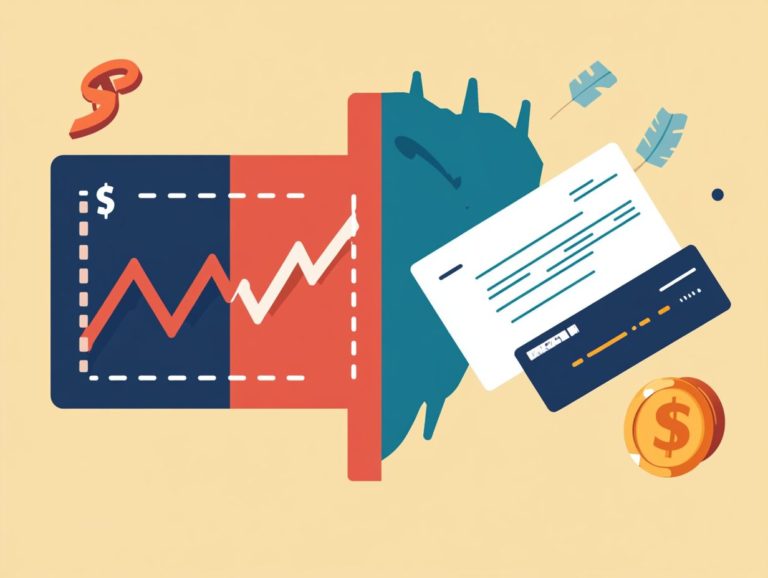5 Steps to Strengthen Your Risk Management Strategy
In today’s fast-paced business landscape, effective risk management is more crucial than ever for you. Understanding potential threats and having a solid plan in place can truly make the difference between success and failure.
This guide outlines five essential steps to elevate your risk management strategy, from identifying and assessing risks to developing and implementing robust mitigation plans.
You’ll explore key components of risk management, familiarize yourself with common business risks, and learn techniques to actively engage your team in this vital process.
Dive in and equip your business with the essential tools it needs to thrive.
Contents
- Key Takeaways:
- 1. Identify Your Risks
- 2. Assess the Likelihood and Impact of Each Risk
- 3. Develop Risk Mitigation Strategies
- 4. Implement and Monitor Your Risk Management Plan
- 5. Continuously Review and Update Your Risk Management Strategy
- Why Is Risk Management Important for Businesses?
- Preguntas Frecuentes
- 1. Cu les son los 5 pasos para fortalecer tu estrategia de gesti n de riesgos?
- 2. C mo puedo identificar riesgos potenciales en mi negocio?
- 3. Cu l es la importancia del an lisis de riesgos en la gesti n de riesgos?
- 4. C mo eval o los riesgos identificados en mi estrategia de gesti n de riesgos?
- 5. Cu les son algunas estrategias comunes de tratamiento de riesgos?
- 6. Qu tan importante es monitorear y revisar regularmente tu estrategia de gesti n de riesgos?
Key Takeaways:

- Identify potential risks for your business to have a solid foundation for risk management.
- Assess and prioritize risks based on their likelihood and potential impact to effectively allocate resources.
- Develop and implement effective risk mitigation strategies to minimize potential damages.
1. Identify Your Risks
Identifying risks is an essential first step in effective risk management. It enables you to recognize potential threats that could impact your business operations.
Consider employee well-being and overall financial stability. This process involves a thorough investigation into various risk categories, including cybersecurity threats, natural disasters, financial risks, and health risks, all of which can severely hurt your organization s performance and erode stakeholder trust.
Operational risks might emerge from internal processes, systems, or even human errors. Strategic risks often arise from external factors, such as market fluctuations or shifts in consumer behavior.
Don’t overlook compliance risks, as they can present significant challenges if ignored, particularly in relation to rules and laws.
Enhance your risk assessment by using group brainstorming. This approach fosters collaboration and allows for a rich diversity of perspectives.
By involving employees from various departments, you not only enrich the identification process but also cultivate a shared understanding of risks. This gives the power to your workforce to contribute to a culture of safety and vigilance, making everyone an active participant in risk management.
2. Assess the Likelihood and Impact of Each Risk
Assessing the likelihood and impact of each identified risk is essential for effective risk management. It allows you to prioritize your responses and allocate resources efficiently to mitigate potential hazards.
By employing a blend of descriptive and numerical methods, you can cultivate a more comprehensive understanding of the risks at hand. The descriptive approach often involves tapping into expert judgment and conducting surveys to gather valuable insights from team members, while numerical methods leverage data to quantify risks through statistical analysis.
Understanding both the risk s chance of happening and its impact helps you form a clearer risk profile. This thorough assessment shapes your risk prioritization, ensuring that high-impact threats are addressed swiftly, ultimately safeguarding your organization s objectives and enhancing overall resilience.
3. Develop Risk Mitigation Strategies
Developing effective risk mitigation strategies is essential for you as an organization aiming to minimize the impact of identified risks while ensuring operational resilience and business continuity.
These strategies can encompass:
- Risk acceptance, where you acknowledge a risk yet choose to proceed without making changes.
- Risk transfer, which typically involves outsourcing certain risks through insurance or contractual agreements. For instance, a tech firm might use insurance to shift the financial burden of a cyber attack, thereby safeguarding its bottom line.
- Risk avoidance, as when a startup decides to steer clear of a high-risk market altogether.
In all these scenarios, having a well-structured plan not only protects your assets but also fosters trust and credibility with clients and investors.
4. Implement and Monitor Your Risk Management Plan

Implementing and monitoring a robust risk management plan is crucial for you to effectively navigate the complexities of your risk landscape and adapt to changing circumstances, following best practices for risk management.
By leveraging project management tools, you can systematically track risks and develop comprehensive mitigation strategies. These tools not only help you identify potential threats but also streamline communication among your stakeholders.
Continuous monitoring is essential. It allows you to make timely adjustments based on real-time data and regulatory changes. Adhering to established frameworks enhances accountability and keeps all stakeholders informed.
This proactive approach builds a culture of resilience within your organization, enabling your business to thrive even in the face of uncertainty.
5. Continuously Review and Update Your Risk Management Strategy
Continuously reviewing and updating your risk management strategy is vital to keep pace with today s dynamic business environment. This ensures that your organizational risks are effectively managed over time.
Regular assessments help you identify emerging threats and provide valuable insights into the effectiveness of your existing protocols.
Engaging in clear stakeholder communication is important as it fosters the exchange of critical information, ensuring that key personnel are aligned and aware of potential challenges. Adaptability is crucial; your recovery plans must be flexible enough to accommodate new risks and evolving business conditions. This allows you to pivot swiftly and minimize disruptions.
Through these collaborative efforts, you can significantly strengthen the resilience of your overall risk framework.
Why Is Risk Management Important for Businesses?
Risk management is essential as it safeguards your ability to keep the business running, enhances stakeholder trust, and contributes to long-term financial stability by minimizing exposure to potential risks and uncertainties in your business environment.
It plays a vital role in following rules that change over time, helping you avoid the financial pitfalls of hefty fines or penalties. By actively identifying and addressing vulnerabilities, you can protect against data breaches and cybersecurity threats, securing sensitive information and maintaining customer confidence.
Effective risk management not only prevents potential crises but also gives you the power to make informed strategic decisions. This proactive stance fosters innovation and opens doors to new opportunities, making it a fundamental pillar of your overall business success.
What Are the Common Types of Risks for Businesses?
You encounter a multitude of common risks that can jeopardize your business operations, including financial uncertainties, cybersecurity threats, operational hazards, and health risks affecting employee well-being and productivity.
Financial risks can emerge from economic downturns, which may require you to reevaluate budgets and forecasts. Meanwhile, cybersecurity threats, such as data breaches, can expose sensitive customer information, leading to reputational damage and potential legal issues.
Operational risks often present themselves through workplace accidents, putting employee safety at risk and causing costly downtime along with increased insurance premiums.
Identifying and managing these risks starts with comprehensive assessments, regular training, and investing in robust technology solutions. By doing so, you can proactively safeguard your assets and maintain a resilient operational framework.
Start assessing your risks today to secure a brighter future for your business!
How Can a Business Prioritize Risks?

Prioritizing risks is an essential process for you as a business leader. It enables you to allocate resources effectively and ensure that the most significant threats to your operations are addressed first.
By employing various methods such as risk analysis tools and prioritization charts, you can systematically evaluate potential risks based on factors like likelihood and impact. These tools provide a clearer understanding of risks and guide your decision-making.
Engaging stakeholders throughout this phase is crucial. Their insights can uncover valuable perceptions of risk and help you shape more informed strategies.
This collaborative approach ensures that your prioritization reflects a comprehensive view of your organization s risk landscape. Ultimately, this leads to enhanced resilience and effective resource management.
What Are the Key Components of a Risk Management Plan?
A well-structured risk management plan is a finely tuned machine. It comprises several key components that work together to identify, assess, and mitigate risks while ensuring effective monitoring and response strategies are in place.
These components form the backbone of the entire process, starting with risk identification, where potential threats are unearthed and documented. This step allows you to be aware of what challenges may lie ahead.
Next comes risk assessment. This evaluates both the likelihood and potential impact of these risks an essential move for prioritizing them effectively.
Once you ve assessed the risks, you can craft a tailored risk treatment strategy. This includes various measures designed to eliminate or minimize those risks.
Risk monitoring then takes center stage. This ensures that the effectiveness of your strategies is continually evaluated, enabling you to make timely adjustments.
By regularly reviewing these components, your organization can swiftly respond to emerging risks that could affect operations and reputation. This maintains a proactive stance in the ever-evolving landscape of risk.
What Are the Tools and Techniques Used in Risk Management?
You can leverage a variety of tools and techniques in risk management to elevate your processes of risk identification, assessment, and mitigation. This ultimately empowers your business to navigate its risk landscape with confidence.
Among these tools, risk assessment software provides data-driven insights. This enables you to evaluate potential threats systematically.
Project management tools are essential as they integrate risk management practices into your daily operations. This makes it easier for you to track progress and address issues in real-time.
Utilizing established frameworks for conducting risk analysis standardizes your procedures. This ensures consistency and thoroughness in your assessments.
Together, these resources enhance your capacity to monitor risks continuously. They foster an environment of proactive improvement and adaptation in your risk management strategies.
How Can a Business Involve Employees in Risk Management?
Involving your employees in risk management is vital for success! It creates a collaborative environment that enhances risk identification and fortifies your organization s overall strategy.
By actively engaging your staff through targeted training programs, you can educate them on potential risks. This also empowers them to take ownership of these challenges.
Group brainstorming sessions provide a dynamic platform for sharing diverse perspectives. This fosters innovative solutions and ensures that every voice contributes to the conversation.
Maintaining open communication channels encourages transparency and trust. It allows employees to express concerns or insights without hesitation.
This holistic approach nurtures a culture of risk awareness. Everyone feels a shared responsibility for safeguarding the organization, ultimately leading to a more resilient workplace.
Preguntas Frecuentes

1. Cu les son los 5 pasos para fortalecer tu estrategia de gesti n de riesgos?
Los 5 herramientas para una gestión de riesgos efectiva son: identificación, análisis, evaluación, tratamiento y monitoreo.
2. C mo puedo identificar riesgos potenciales en mi negocio?
El primer paso es identificar riesgos posibles. Esto implica analizar factores internos y externos que podr an amenazar tu negocio, como problemas financieros o reputacionales.
3. Cu l es la importancia del an lisis de riesgos en la gesti n de riesgos?
El an lisis de riesgos es fundamental en este proceso. Ayuda a identificar y evaluar la probabilidad y el impacto de problemas potenciales.
4. C mo eval o los riesgos identificados en mi estrategia de gesti n de riesgos?
Despu s de identificar y analizar los riesgos, eval alos seg n su probabilidad e impacto. Esto te ayudar a decidir cu les necesitan atenci n inmediata.
5. Cu les son algunas estrategias comunes de tratamiento de riesgos?
Las empresas pueden utilizar varias estrategias para mitigar riesgos. Algunas incluyen evitar, transferir, reducir o aceptar riesgos, dependiendo de su posible impacto.
6. Qu tan importante es monitorear y revisar regularmente tu estrategia de gesti n de riesgos?
Monitorear y revisar tu estrategia es crucial para mantener su efectividad. Los riesgos pueden cambiar con el tiempo, por lo que ajustar tu enfoque es esencial.






